Figure 5.
Protective effects of fucoxanthin on LPS-induced abnormal pupillary light reflex and denervation of the iris. The pupil diameter in response to pupillary light was compared among the blank control (A,B), LPS/vehicle (C,D), and LPS/10 mg/kg BW of fucoxanthin (E,F) groups. Abnormal pupillary light reflex was observed in the LPS/vehicle group relative to the control group, whereas the impaired reflex was alleviated in the LPS/10 mg/kg BW of fucoxanthin group (G). In addition, nerve innervation in the sphincter area was evaluated via immunohistochemical analysis of the general neural marker PGP 9.5. Nerve innervation was also compared among the blank control (H), LPS/vehicle (I), and LPS/fucoxanthin (J) groups. There was a significant reduction in nerve innervation in the sphincter muscle of the iris with evident LPS-induced nerve injury in the LPS-treated group (I) relative to in the blank control group (H), whereas nerve innervation was increased by treatment with fucoxanthin (J). Semi-quantification analysis of nerve innervation was calculated in the sphincter area and the results are presented as the mean ± SD (n = 5). Denervation in the sphincter region of the iris was reduced in the 10 mg/kg BW of fucoxanthin pretreatment group as compared to the LPS group (K). * p < 0.05: Compared to the LPS/vehicle group (Student’s t-test). Scale bars: 50 μm.

